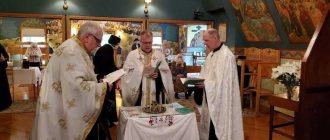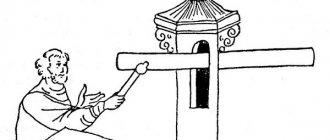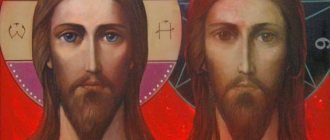Only God is absolutely holy. At the same time, the church canonize people as saints. On this topic, the author and presenter Vitaly Starikov talks with the rector of the Rakity St. Nicholas Church, Archpriest Nikolai Germansky.
“The conversation about holiness is a difficult conversation, especially in our time. Someone will say: what holiness, what spiritual height, when we survive? What transformation, what ascension, what self-denial? But if we don’t talk about holiness, we will soon see even more terrifying things,” says Nikolai Germansky .
What is holiness
Holiness is spiritual perfection. Only God is absolutely holy. In the understanding of human holiness there is constant and sincere spiritual improvement, which must end in spiritual height. It is expressed in humility, kindness, faith, hope and, most importantly, love. When Christ came into our world, he came to remind everyone of this, although he knew what price he would have to pay.
“In the understanding of human holiness there is a constant, steady and sincere spiritual improvement, which must ultimately end in spiritual height. It is expressed in humility, kindness, faith, hope,” says Nikolai Germansky .
Holiness
Isn’t it true that “holiness” is often called something that one does not intend to do? “He’s a saint, I can’t do that” - that’s a sure-fire alibi! “I’m not a saint” is the best way to cover up your sins.
If the “holiness” of everyday speech and thought is “not about us,” then who is it about? There are several options.
1) Occult point of view: there are supernatural beings, all in light and gold - “saints”, and their function is, of course, to help magically. Or even more than that: there are holy objects and substances that, of course, heal something.
2) Moralistic option: a “saint” is an amazing “morally perfect” individual, frightening with his perfection. Since birth, he did not take his mother’s breast on Wednesday and Friday, since childhood he did not like noisy games... The reader clearly understands: this is not about him.
3) The approach of idolaters: “a shrine”, “this is sacred to us.” It’s a dangerous thing - after all, where there are idols, there is blood: what to do with a shrine, other than kill for it?
Any perversion is a perversion of the norm; Only what was healthy gets sick. Likewise, any false understanding is only a perversion of the correct understanding.
Of course, the holy is different, distant, healing, perfect and good, to be worshiped: the holy is God. He is the only truly Holy One, in Hebrew - “kadosh”, that is, another, separate, unworldly. Sacred is that which is dedicated to God.
To be with God means to be holy, that is, the way a person was intended by God. To be holy means to be in general (to belong to Being, that is, to God), to enter into eternal life, to be perfect, whole, healthy.
Sin is disconnection from God, non-life with Him - Life. Ultimately, sin is death, the abomination of desolation, hell. God does not want death, therefore the history of the world is the history of salvation, the reunification of the whole world with God. To be saved means to be with Him, to become God by grace.
“Be perfect, as your Heavenly Father is perfect” - this commandment of Christ is suspiciously rarely remembered. Man was conceived by the Creator as a saint. In this sense, we are all potentially holy: Israel is holy because it is dedicated to God, the Church is holy because She is God’s: Christians once called themselves saints “simply” by belonging to the Body of Christ. If we do not become saints, we will finally fall away from God, the source of life, and “die to hell.”
Therefore, as Leon Bloy says, “there is only one grief - not to be a saint”: not to be with God is eternal death. But the Good News (i.e., Joyful, Cheerful, Encouraging) is that there is salvation.
On the path of achieving holiness, the canonized saints of the Church serve as an example to us. In communion with God and with each other, they form the Triumphant Church, to which the whole world must turn after the Second Coming.
Lisa from the animated series “The Simpsons” in one of the episodes says: “I don’t deny the existence of angels, but I don’t believe that any of them could appear in our garage.” This is the slogan of a true agnostic (and it seems there are no more good old atheists left): whether there is a God or not is not important, but this is not about me, not about life. This is the essence of unbelief. But saints are “angels in our garage”: real people, with sins, problems, addictions - just like us, but who have fulfilled the commandment of perfection.
What are the signs of holiness
All the signs of holiness can be found in the Sermon on the Mount, which is presented in the Gospel of Matthew. In the worldview of Western people, love is replaced by humanism, patience - by tolerance, that is, tolerance for any sin. Their concept of freedom is distorted: for them it is freedom to sin, but for us it is freedom from sin. Instead of spiritual bliss, they chose earthly pleasure. Meanwhile, holiness is bliss: blessed are the pure in heart, the meek, the weeping, the merciful, those who will endure all suffering for Christ. Saints are patient, kind, sincere, full of faith, hope, and love.
Mikhail (Mudyugin), archbishop. Holiness, sanctification, saints
One of the most common metaphors in liturgical doxology is calling God the Sun: I bow to you, the Sun of truth, the Church sings in the Christmas troparion; Light, greater than all lordships... Sun of truth, illuminate me; Holy light, covering me, prays an Orthodox Christian in the words of one of the most ancient akathists. Such a comparison, despite the convention inherent in it, as in any comparison of the creature with the Creator, the finite and relative with the eternal and absolute, is fully justified not only because the sun, in its size and amount of emitted energy, far exceeds all other sources of energy within its system , but also because, having a supply of nuclear energy independent of external influences, the sun is the only source for all energy processes occurring in its system, since all other sources have an intermediate, mediating nature, borrowing their energy potential from the sun for a relatively short period of time (plants, animals) or much longer (coal, oil). The sun is the primary source of energy reserves available to the globe and other planets.
So God, absolutely independent of anything, having the cause of Himself in Himself, appears to us as the cause of everything that is not God, the Creator visible to all and invisible 17. Everything that exists in the spiritual and material world is the result of the energy emitted by Him 18 , in particular and especially, people can say to themselves in the words of the Apostle Paul: In Him we live, and move, and have our being (Acts 17:28), for He Himself gives to all things life and breath and all things (v. 25; see also Ps.32:6,9; 148:5).
The holiness of God, by which we, as said above, understand His unsearchable and inexpressible superiority over everything that exists, over all being, surpassing all understanding, as well as the totality of all the hidden Divine properties revealed to us and from us, radiates, pours outward, into the created world, and in it the cause and source of all angelic and human holiness, just as the will of God for the existence of the universe is the cause and source of the existence of the visible and invisible world. As creation, the action of God in His unity
Hypostases (Ps. 32:9), however, are carried out through the Divine Word, through the Logos (John 1:3), so sanctification, that is, the communication of holiness to created objects from the only Source of holiness - God, is accomplished by the power and action of the Holy Spirit.
The highest event, the accomplishment of such sanctification, should undoubtedly be recognized as the influx of the Holy Spirit onto the Most Pure Virgin Mary for the birth from Her of the Son of God, the Holy One to be born (Luke 1:35). According to the meaning of Archangel Gabriel’s answer to Mary’s bewilderment, the condescension of the Holy Spirit should have been the cause of both the birth itself and the holiness of the One Born as the Son of God.
And in other places in the first chapters of the Gospel of Luke we find a number of examples of the sanctifying action of the Holy Spirit: the filling of John the Baptist with the Holy Spirit from his mother’s womb (Luke 1:15) is foreshadowed by his father Zechariah, who, after the birth of John, prophesies about his son, again under by the influx of the Holy Spirit (Luke 1:67); The Holy Spirit dwelled on Simeon the God-Receiver, which the text associates with his righteousness, piety and messianic expectations (Luke 2:25). The Divine Infant had the grace of God on him (v. 40), which is synonymous with the action of the Holy Spirit. From the same verse it is clear that the presence of grace on Him was by no means identical to growth, strengthening in spirit and being filled with wisdom, which can be understood as an assessment of natural age development. Finally, when... Jesus, having been baptized, prayed on the banks of the Jordan, the Holy Spirit descended on Him in bodily form, like a dove (Luke 3:21-22). Here the sanctification of the human nature of Christ took place with the simultaneous proclamation of His Divinity in unity with the Father and the Holy Spirit, after which Jesus, filled with the Holy Spirit, returned from the Jordan and was led by the Spirit into the desert, where he was tempted by the devil (Luke 4: 1-2 ).
The holiness of Jesus Christ as the Son of God was mysteriously combined with His holiness as an illuminated man imbued with the Holy Spirit. This divine-human holiness fully possessed that exclusive isolation raised above everything around it, which, as noted, is an integral sign of holiness.
It was this holiness, exceeding any other, any created holiness, that had such a terrifying and painfully striking effect on the demons, who, through the mouths of people possessed by them, at the mere approach of Jesus Christ, shouted: Leave! What do you care about us?
67
Jesus of Nazareth? You have come to destroy us! (in Matthew - to torment us ahead of time). I know You, who You are, the Holy One of God (Mark 1:24; cf. Matt. 8:29; Mark 5:7; Luke 8:28). The holiness of Jesus Christ aroused instinctive disgust and hatred towards Him also among people who indulged in vices, primarily Pharisee hypocrisy, exaltation, pride and lust for power (Luke 6:11). From the outside she encountered bewilderment and misunderstanding, as, for example, from those many disciples who left Him and no longer walked with Him (John 6:66), the brothers who did not believe in Him (John 7:4, 5; Mark 6:2-5) or Pilate, who asked in bewilderment: Where are you from? (John 19:9). Here the words of the Savior were fulfilled, that everyone who does evil hates the light and does not come to the light (John 3:20); but further He says that he who acts in truth comes to the light, so that it may be revealed. were his works (v. 21). And indeed, what was holy and pure in human souls responded to the call of Christ and was drawn to Him. But here, too, the primary reaction was the feeling of the exclusivity of the Personality of the God-Man, His superiority over all His surroundings, even over everything that the best of the best could dream of, from among those who looked forward to the consolation of Israel (Luke 2:25), that is, the feeling of His holiness. Never has a man spoken like this Man (John 7:46), testified the ministers who did not want to lay hands on Him, as they were ordered by the high priests and Pharisees. Only for a few did this experience reach the level of awareness, like the Capernaum centurion (Matt. 8:5-13; Luke 7:1-10), Nathanael (John 1:49), and the Apostle Peter (Matt. 16:16) ) and, finally, from the Apostle Thomas, who first confessed Christ as Lord God (John 20:28).
The sanctification of Christ's disciples took place in the process of His communication with them in the last years of His earthly life: You have already been purified through the word that I preached to you (John 15:3), but the sanctification that communicated to them and to all who were of one accord with them, the holiness of the members of the Church of Christ (Acts 2:1-12) took place only on the day of Pentecost. From that moment on, in the words of the Apostle Paul, they became sanctified by God the Father, by the name... of Jesus Christ and by the Spirit of God (1 Cor. 6:11; Jude 1:1). Through the baptism of the Holy Spirit and fire (Matthew 3:11), God formed from them the Holy Church with the Head of the Lord Jesus, from Whom, as members of His Body, they received holiness, that is, they were sanctified.
This holiness extends to all those entering the Church through Holy Baptism, which gives Paul, as well as the other apostles (Acts 9, 13, 32, 41; 26, 10), the basis to call the members of the communities - the recipients of his messages - nothing less than saints , to whom he sends his greetings (Rom. 16:15; Heb. 13:24; Eph. 1:1; Phil. 4:21), for whom he collects and exhorts to collect relief (1 Cor. 16:1; 2 Cor. 9, 12; Eph. 1, 15), to whom he forbids to resolve conflicts that arise except by the court of saints like themselves (1 Cor. 6, 1).
The Church’s confidence in the holiness of its members was clearly reflected in the most ancient liturgical monuments: thus, in the Divine Liturgies of Saints Basil the Great and John Chrysostom, at the small entrance: “Blessed is the entrance of Thy saints,” after the Eucharistic canon: “Having remembered all the saints...”, finally, at the ascension of the Lamb: “Holy to the holy!”, to which the choir replies: “One is holy, one Lord Jesus Christ to the glory of God the Father,” thereby affirming the holiness of God as the only Source of all created holiness.
Holiness, or sanctification, is possessed not only by the Church as a whole, not only by each of its members, but also by Local Churches, that is, groups that form part of the Universal Church and at the same time possess the fullness of grace-filled holiness inherent in the entire Church as a whole. This is one of the most important properties of the Church - its catholicity, which includes, among other things, the independence of the grace of any of the communities from its size. As is known, Jesus Christ addressed His followers as a little flock (Luke 12:32) and promised His co-presence even to two or three who gathered together in His name (Matthew 18:20). The inherent isolation of the Church, as a holy organism, from the environment, from the “world,” is clearly visible throughout New Testament writing. Jesus Christ Himself speaks about this especially clearly in his farewell conversation: If you were of the world, then the world would love its own; and since you are not of the world, but I chose you out of the world, therefore the world hates you (John 15:19) and in the high priestly prayer: I delivered your word to them; and the world hated them, because they are not of the world, just as I am not of the world (John 17:14). The Apostle Peter, characterizing in elevated terms the holiness of the members of the Church, calls their totality, that is, the Church, a holy people, the people of God, a people taken for his own possession, a royal priesthood (1 Pet. 2:9-10), using the same expressions that in the Old Testament the sanctification of the chosen people was established, their isolation from all other nations, from all humanity (Ex. 19: 5-6; Deut. 9: 29). As can be seen from the same words of the apostle, this kind of holiness, taught through being born again ... of water and the Spirit, that is, through faith in Christ and Baptism (John 3:3, 5), is identical to the universal priesthood about which the word of God speaks ( Rev. 1:6; 20:6; 1 Pet. 2:9; Eph. 4:12) and which, along with the hierarchical priesthood, is inherent in the Orthodox Church.
As we have seen, the perception of this holiness, otherwise grace-filled sanctification, is carried out in the Sacrament of Holy Baptism, its strengthening and consolidation - in the Sacrament of Confirmation, and constant renewal and restoration (a kind of regeneration) - in the Sacrament of the Eucharist 19. In many cases, the perception of sanctification can occur and occurs passively, as they say, “according to the faith of the whole Church,” for example, during Baptism and communion of infants and people dying in an unconscious state 20, but in principle, the grace-filled acceptance of Holy Baptism and the Holy Eucharist requires conscious faith, conscious desire, appropriate external and internal preparation (1 Cor. 11, 27; Acts 2, 38, 46; 8, 15-17; 26-39; 16, 30-33).
Raising the problem of sanctification in a theological aspect, we have to admit that the only purpose of sanctification, as well as the only purpose of the existence of the Church through which this sanctification is accomplished, is the salvation of those being sanctified 21. In fact, the highest
68
The greatest sanctifying act - the sanctification of human nature by taking it upon Himself by the Son of God with its subsequent combination with God in the ascension and in the settlement at the right hand of the Father had the sole purpose of saving the human race. God so loved the world that He gave His only begotten Son, so that whoever believes in Him should not perish, but have Eternal Life (John 3:16).
In the word of God we find only indirect indications of the purpose of the creation and existence of the Church, but the sanctifying care of God’s Providence for it (Eph. 4:11-16), the love of Christ for it (Eph. 5:25-26), the leadership exercised by Him as its Head (v. 24), as its Savior (v. 25), allow us to judge that it is an instrument of salvation, of attracting people to the life-long glorification of God, otherwise - to a blissful participation in His Glory, ultimately to deification (John 10, 35; Matthew 13, 43; Rom. 8, 17, 30; 1 Cor. 6, 20; 2 Thess. 1, 10-12). So, through the Church of Christ, God sanctifies people, introduces them to His eternal Kingdom, gives them salvation, that is, Eternal Life 22.
Speaking about holiness as a result of sanctification coming from God, we noted isolation from the environment and superiority over it as properties and signs of holiness that are inherent in it. However, both of these properties are predominantly external in nature and can be attributed to secular objects that do not pretend to be sacred. They speak not so much about the holiness of the object in essence, but about its relationship with the environment.
Undoubtedly, holiness, or, since we are talking about objects of sanctification, sanctification, there is something inherent in it that is ontologically inherent and which is the cause that inevitably distinguishes the sanctified object from everything unsanctified, “worldly,” “secular,” which is the cause of both noted properties. The ontology of sanctification should be sought in its origin, in the holiness of God, which is the Source of all sanctification of created objects, whose holiness in relation to the Divine holiness is always secondary, always borrowed from it.
It is precisely the conjugation of the holiness of any objects with its Source - the holiness of God - that should be considered as the cause of sublime feelings, even ecstasy and exaltation, that arise in people who come into contact with a shrine or are exposed to its influence. Here is also the reason for the no longer psychological, but purely existential impact of the shrine on spiritual and material nature, in particular spiritual conversion and rebirth (Acts 9), healings and other types of manifestation of spiritual powers caused by sanctification.
So, the ontological specificity of such secondary holiness is the communion of an object with the holiness of God, and sanctification is nothing more than the process of communion, as a result of which a given object, primarily a person (or an Angel), receives grace-filled participation in Divine holiness, participates in Glory God's. It is not difficult to see that man received such sanctification already in the act of his creation. Created in the image and likeness of God, he possessed the grace of communion with God, which sanctified him without encountering any resistance or inhibition. However, sin, that is, the opposition of the good human will, which directs the will of God to bliss, removed man from God, created a barrier between God and man, and salvation, accomplished by the Son of God, was required for its destruction (Eph. 2:12-20), to ensure the possibility of new grace-filled sanctification for everyone who comes with faith in the Savior of the world.
It can even be argued that in the process of creation, all creation received sanctification: already through the creative influence of the Holy Spirit (Gen. 1, 2) it arose and was formed into the holiness of God.
Here we come close to the problem of the sanctification of inanimate, so-called “dead” matter.
In fact: the sanctification of children during their Baptism at an unconscious age has a decisive impact on their future spiritual life and forever determines their adoption to God. What is the real meaning of the consecration of inanimate objects, which is widespread in the practice of the Catholic Churches?
Here, of course, there is an external sign of sanctification - the isolation of this object from all others that are similar, similar or identical to it in their external characteristics - weight, size, material, configuration and others. However, the basis of this very distinction is the mystical connection of the sanctified object with the grace-filled sources of sanctification, and ultimately with God, who influences created objects with the power of the Holy Spirit, imparting grace-filled properties to them.
Let us give several biblical examples of such sanctification. The sanctified place was not only the bush that burned and did not burn, but even the approaches to it: “Take off your shoes from your feet,” Moses was told, “for the place on which you stand is holy ground (Ex. 2-5).
Mount Sinai was also a sanctified place, to which only God’s chosen one Moses had access, and the entire Israeli people, despite the sanctification to which they had undergone, did not dare to cross the line drawn by Moses by Divine command (Ex. 19: 10-15). In both cases, the immediate Source of sanctification was God Himself. However, the tabernacle, the altar, the vestments of Aaron and his sons - all this was consecrated by Moses through anointing, just as Aaron himself and his sons received the priesthood through anointing (Ex. 9: 8-15).
The spirituality of the New Testament, its abolition of the ritual and everyday institutions of the Mosaic legislation, which had lost their saving effectiveness and significance, did not abolish the laws of the process of sanctification of both people and material objects. Enough has been said above about the sanctification of the chosen Israeli people and even more about the sanctification of New Testament Israel - the Christian Church and its members. However, the reality of sanctification and individual inanimate objects finds new confirmation in the New Testament. The most authoritative in this regard should be considered the statement of Jesus Christ Himself, indicating the sequence of sanctification coming from God, passing on to the temple, the gold decorating it, to the altar and the sacrifice made on it (Matthew 23: 18-21). From the Acts of the Apostles we
69
we learn about the miraculous properties inherent in the scarves and aprons worn by the Apostle Paul (Acts 19:12); the shadow of the Apostle Peter had the same beneficial effect (Acts 5:15).
Knowing that the grace of God blesses and sanctifies all things 23, the Orthodox Church consecrates churches, dwellings, bells, church utensils, icons, vestments and even objects of secular and everyday use. 24. A special place among the acts of consecration is occupied by the blessing of water, which is performed often, and in some cases (on the feast of the Epiphany) - with special solemnity. As is known, the consecration of water is accomplished by immersing a cross in it, the sanctifying effect of which is determined by the inseparability in the Christian consciousness between the sign of the cross and the fact of the crucifixion of the Savior of the world on it. It can be assumed that life-giving, sanctifying grace is given by God to the sign of the cross precisely for the purpose of maintaining and strengthening the constant remembrance of the Calvary Sacrifice offered for the sake of our salvation. In turn, any other objects are sanctified with holy (more precisely, consecrated) water. The use of water as a mediating agent of sanctification is explained, apparently, not only by the convenience of its use for immersion, sprinkling, consumption, but also - and mainly - by its use for Baptism, the use indicated by Christ Himself (John 3:5; Matthew 28:19; Mark 16:16).
The preservation of the phenomenon of sanctification of material objects in the New Testament does not mean, however, that the Old Testament emphasis on sanctification has remained untouched. The ritual, external side of consecration is largely relegated to the background, and the person, his spirituality, his attitude towards God and people is put in the foreground.
Love is put at the forefront (Matthew 22:37-40; John 13:34-35)—the state that most reveals the ontological Godlikeness of man (1 John 4:16); it is precisely this that is the source and essence of sanctification and holiness, for God is love (1 John 4:8, 16), and everything done out of love sanctifies a person.
As a result, many external things that were a prerequisite for sanctification for the Old Testament man fell away or received a completely new meaning. Physical circumcision fell away (Gal. 6:15), sacrifices fell away (Heb. 10:18), and the sacred significance of the Jerusalem Temple fell away (John 4:24). The concept of the temple expands and spiritualizes; The Most High does not live in temples made with hands (Acts 17:24), preaches the Apostle Paul in Athens; Every Christian can be a temple, that is, a place of special residence of God (1 Cor. 3:16; 6:19), and the whole Church receives the name temple (Eph. 2:21; 2 Thess. 2:4). It is very significant that in the holy city of Jerusalem of the next century there will be no temple at all, for the Lord God Almighty is its temple (Rev. 21, 22). Thus, from an eschatological perspective, the expansion of the concept of the temple goes into Divine infinity.
What has been preserved from the Old Testament is subject to observance only to the extent that it does not contradict the spiritual and even physical needs of man. Thus, the Sabbath rest must be observed only to the extent that it does not interfere with the satisfaction of human needs (Luke 6:9-10); This is how you can carry out actions that disturb the peace if hunger forces you to do so (Mark 2:23-28); The principle of the Sabbath is proclaimed for man, and not man for the Sabbath (Mark 2:27).
The antipode of sanctification, as is known, is desecration, desacralization. The corresponding ideas also underwent radical changes in the New Testament. External defilement, external impurity loses its sinful significance completely or to a significant extent. It is immaterial from a moral point of view whether food is taken with washed or unwashed hands (Matt. 15:20); even the previously ritual washing of vessels does not matter (Mk. 7:4; Luke 11:38-41); the center of gravity of defilement is transferred to the heart, in other words, to the spiritual state of a person, for it is not the food and drink that enters the mouth that defiles, but the evil that comes from the heart, in particular through the mouth, in all its varieties and manifestations (Matthew 15:10- 20; Mark 7, 18-23).
The basis for such a radical reorientation is laid in the truth that God is spirit, and those who worship Him must worship in spirit and truth (John 4:24).
All sanctification has God as its source and man as its final object. When God seeks His worshipers in spirit and truth (John 4:23), then the sanctification sent down to them can, according to His holy will, be carried out through visible, material mediation, but it can also be immediate, in accordance with the words of the prophet; I will pour out My Spirit on all flesh... and it will be that everyone who calls on the name of the Lord will be saved (Joel 2:28, 32; Acts 2:17, 21).
The thief on the cross underwent this direct sanctifying influence of grace; he was not sanctified by water baptism, did not receive the remission of sins certified by the priest in the Sacrament of Repentance, was never a participant in Eucharistic communion, all this was replaced by the words of the Savior that sanctified him: Today you will be with Me in Paradise (Luke 23:43). The words of Christ addressed to the disciples fully apply to him: You have already been cleansed through the word that I preached to you (John 15:3). The promise given to him contained everything: spiritual birth, and the complete erasure of his sins, and participation in the Eucharistic sacrifice, which was primarily performed at that moment, but not on the throne of the temple, but on the Calvary Cross, on which the Son of God hung next to him.
MICHAEL,
Archbishop of Vologda and Veliky Ustyug
(End to follow)
MAGAZINE OF THE MOSCOW PATRIARCHY
No. 12, 1087
Moscow
The page layout of this electronic article corresponds to the original.
Topic: The concept of holiness in Russian Orthodox culture. Holy warriors.
The ideal of holiness has become the highest moral ideal for Russian people, the embodiment of enduring spiritual values in earthly life.
In Kievan Rus, Christian teaching, adopted from Byzantium, was combined with the foundations of the spiritual worldview and cultural traditions of the Slavs who made up its population. As a result of this connection, the multilateral spiritual power was formed, implied by the concept of the holiness of Rus'.
Each nation has developed its own customs—rules of behavior that are ingrained in people’s minds and passed on from generation to generation, turning into stable traditions.
For many centuries, the pillars of morality were religious norms that taught compassion, kindness, and marital fidelity. They explained that you cannot do to others what you do not want for yourself, and you need to treat people the way you want to be treated. Christian commandments, such as “thou shalt not kill,” “thou shalt not steal,” “love thy neighbor,” and others, formed stability and tranquility in the public consciousness. “There is nothing worse than envy and hatred, there is nothing worse than vanity. Anger is a beast, a cruel and fierce beast. Do not respond to anger, lest you destroy yourself by taking revenge.” Fulfilling religious instructions, people feared God's punishment for their unrighteous lifestyle.
Holy warriors of Rus'
More than a thousand years have passed since Rus' adopted Christianity. Heroic examples of the confession of the holy faith and the martyrdom of soldiers are preserved in the people's memory with special love. A great many warriors, with their courage and willingness to sacrifice themselves for the sake of the Faith and the Fatherland, for the sake of their relatives and friends, more than once saved their people when death seemed inevitable. Very often, grateful descendants erected temples in memory of fallen soldiers. July 12 is the day of the Supreme Apostles Peter and Paul, the day when the Prokhorov tank battle took place in 1943. In honor of the soldiers who died in this battle, it was decided to build a temple, which received its name from the Supreme Apostles Peter and Paul.
St. George the Victorious
George was from Cappadocia, a region in Asia Minor. He grew up in a Christian family. Having enlisted in the Roman army, he was noticed by Emperor Diocletian and accepted into his guard with the rank of comit - one of the senior military leaders.
Having learned about the decision of the pagan emperor to give complete freedom to the rulers in reprisals against Christians, George distributed his inheritance to the poor, freed his slaves and appeared in the Senate, where he openly opposed the emperor, which greatly angered him. For his faith in Christ, George underwent terrible torture: his legs were chained in stocks and a heavy stone was placed on his chest. They spun George on a wheel under which boards with knives were arranged, buried him in lime for 3 days, put him in red-hot iron boots, beat him so that his body and blood mixed with the ground, they tried to poison him, but George remained unharmed. The pagan priests demanded the death penalty. Calmly and courageously the saint bowed his head under the sword. It was May 6, 303.
Ilya Muromets
Little reliable information has been preserved about the life of St. Elijah of Muromets. He was born in 1143 into a peasant family in the village of Karacharovo near Murom. Folk legend identified him with the famous epic hero Ilya Muromets, about whom epics were written. Until the age of 30, Ilya was paralyzed, and then received miraculous healing from 3 prophetic elders. Ilya was in the squad of the Kyiv prince Vladimir Monomakh for many years. He became famous for his numerous military exploits and unprecedented strength, which he used only to protect the Fatherland and the Russian people. In one of the battles with the Polovtsians, he received an incurable wound in the chest, and, obeying the call of his heart, took monastic vows. Many warriors did this, replacing the iron sword with a spiritual sword. Ilya Muromets died in 1188 and was buried in the heroic chapel of the St. Sophia Cathedral.
Alexander Nevskiy
Novgorod Prince Alexander Yaroslavovich showed his talent as a commander when he was 20 years old. In July, a Swedish army led by Duke Birger landed on the banks of the Neva. The Swedes wanted to capture northern Rus' and convert local residents to the Catholic faith. Alexander did not wait for the Swedish army in Novgorod and came out to meet him. Early in the morning of July 15, he attacked the Swedes at the place where the Izhora River flows into the Neva River. The Swedish troops were completely defeated. Only a few managed to escape. After this battle, the prince received the nickname Nevsky.
On April 5, 1242, the German knights were completely defeated on the ice of Lake Peipsi.
As a result of this victory, the attempt of the Teutonic Order to impose Catholicism on Rus' was thwarted. Before his death, Alexander adopted the schema with the name Alexy.
Dmitry Donskoy
In the spring of 1380, Mongol troops stopped on the banks of the Voronezh River. When Prince of Moscow Dmitry Ivanovich found out about this, he said this: “Brothers!” Let's go against the damned, godless and wicked raw foodist Mamai. Let us stand for the Orthodox Christian faith and for the holy churches.” A collection of troops was announced throughout the country to fight Mamai. For spiritual support, the prince turned to St. Sergius of Radonezh. The monk blessed him, gave him two of his monks Peresvet and Oslyabya to help him, and predicted victory.
The battle took place on September 8 (old style) on the day of the Nativity of the Blessed Virgin Mary, on the Kulikovo field, in the place where the Nepryadva River flows into the Don.
The battle was started by two heroes: Peresvet and Chelubey. Both died by piercing each other with spears. Dmitry himself took part in the battle dressed as a simple warrior and almost died. After the battle, they searched for him for a long time and found him lying unconscious, littered with dead soldiers. For the victory on the Kulikovo field, Prince Dmitry began to be called Donskoy.
Peresvet and Oslyabya
Very little historical information has been preserved about these saints. It is reliably known that before accepting monasticism, Alexander Peresvet was a boyar of Bryansk, and Andrei Oslyabya was a boyar of Lyubut. Both of them became famous as valiant and brave warriors. With joy, the monks accepted the command of their abbot to go to battle with Prince Dmitry Ivanovich. According to St. Sergius of Radonezh, the schematic vestments were supposed to replace their armor.











